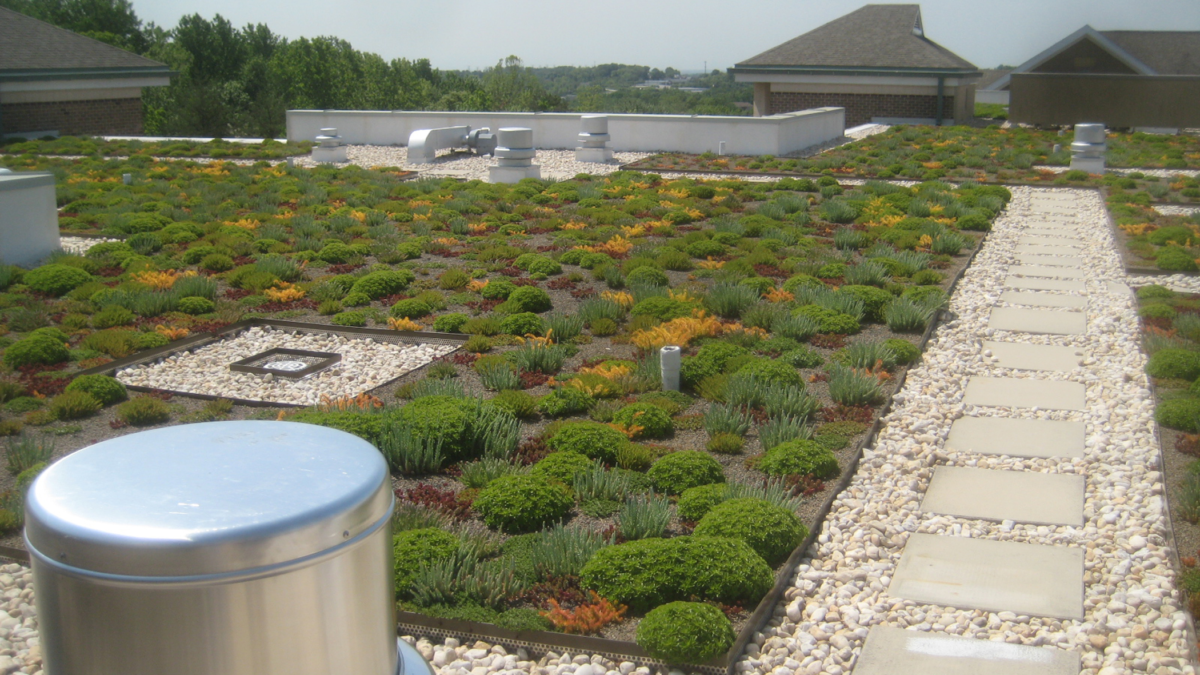
Garland installed

Garland replaced the failing EDPM roof with a vegetative roof that has dropped rooftop temperatures by an average of 50 percent, reduced storm water runoff by 40 percent and dropped energy use by as much as 30 percent.
The Challenge
The single-ply roof over Renaissance Gardens, one of the skilled nursing facilities located on the 85-acre campus of Oak Crest Retirement Village in Parkville, Md., had oxidized, shrunk, split and become brittle, causing significant leakage. In addition, the metal standing seam roof had separated, allowing water to penetrate the building. Rather than pursue a traditional roof replacement, Joyce Malone, director of general services, decided to embrace the recently established “green” culture of the retirement community. Malone wanted an environmentally friendly solution with the long-term performance of a traditional roofing system, so she contacted local Garland representative, Aaron Hundley, who has completed several green roof projects in the Baltimore area.
“This campus has a really large focus on reducing its carbon footprint. We have a resident population that is very involved in recycling and takes great pride in caring for the environment,” Malone reports.
Solution
In keeping with the interests of the retirement community, Hundley recommended the failing EDPM roof be replaced with an extensive vegetative roof system that would meet the company’s performance objectives and also provide numerous environmental benefits. He suggested the failing metal roof be retrofitted with a completely recyclable standing seam system, avoiding a tear off and subsequently reducing landfill waste. Hundley explains, “We took every effort to ensure the entire project was green, from the products chosen, to the installation, to our decision to reuse components from the original roof.”
The failing EPDM roof was removed down to the deck and replaced with an extensive vegetative roof system comprised of Garland’s StressPly® Plus high-strength modified bitumen membrane, chosen for its incorporation of 30 percent recycled crumb rubber and recycled glass; Green-Lock® cold-applied, odor- and VOC-free membrane adhesive; four inches of soil media; and a variety of plants and sedums. All of the exposed flashings were coated with a highly reflective, ENERGY STAR® qualified coating, reducing energy while providing protection against UV rays. In an effort to further reduce landfill waste, the river rock ballast from the original roof was installed around all roof projections, drains, and around the perimeter of the 36,000-square-foot roof.
To repair the failing metal roof, Garland’s R-Mer® Span structural standing seam roof system, which is 100 percent recyclable at the end of its life cycle, was retrofitted over the existing metal roof. To accomplish this, new structural framing was added over the existing roof, tying the new roof directly to the structure of the building. The 24-gauge, 16-inch natural patina Galvalume®* panels were then installed over the new framing with one-piece clips, allowing for unlimited thermal movement and watertight protection. Hundley coordinated the installation of both the green roof and metal retrofit with Control Roofing & Sheet Metal Corp. of Capitol Heights, Md.
Following the installation of the vegetative roof, rooftop temperatures were reduced by an average of 50 percent, storm water runoff decreased by 40 percent and energy use dropped by as much as 30 percent. Malone concludes, “It’s amazing when you go up on the roof and see the beautiful vegetation. It adds so much to the community, not only in terms of environmental benefits, but also in visual appeal. It really is beautiful.”
